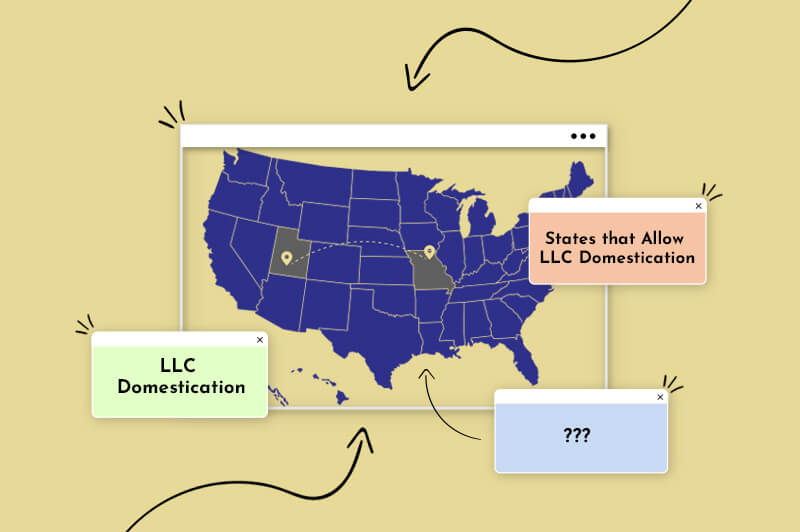
Many entrepreneurs choose a limited liability structure (LLC) to launch, manage, and grow their small businesses. And because of an LLC’s flexible nature, it’s an excellent choice.
That flexibility extends to transferring your LLC to another state, whether to be closer to family or to benefit from lower living and business costs such as a state with no franchise tax. Or, taking on a new challenge to expand your business.
Whatever your reason for moving, you must decide how you’ll move your LLC and you’ve got several options to choose from. Some are easier, some harder, and others depend on your reason for moving.
In this post, we’ll explore them and how you get each option done.

When you change states, you’ve got 4 options with regards to taking your LLC with you. You can:
Let’s dive into each one to see which is best for you.
For most business owners, the easiest option for transferring an LLC is to register it as a foreign LLC in their new location. This option comes with a bonus: If you’re not moving home, you can live in your original state and run your LLC in another.
Not sure what a foreign LLC is? No worries, I’ll explain next.
A foreign LLC is a legal classification for doing business in another state other than the one you initially registered in. States require businesses to register as a foreign LLC when doing business in their state to ensure they meet their regulatory and tax requirements.
For example, if you formed your LLC in California and want to expand to Oregon, you could register as a foreign LLC in Oregon.
When you register as a foreign LLC, it means you’re active in 2 states resulting in paying taxes and fees in both.
That’s fine when doing business in both states. Still, suppose you’re only earning in your new one. In that case, it can be costly as some states charge a minimum annual franchise tax ($800 in California, for example) plus other costs, including yearly accountancy filing fees.
If your original state’s annual fees are too expensive to maintain 2 separate entities, keep reading as we’ll explore your other options next.
Business owners who are switching states for good can transfer their LLC to a new state, also known as domestication. Not all states allow this, but if yours does, it’s an easy option for you and your LLC.
LLC domestication enables you to move your LLC from one state to another and run your business as if formed in that state. Once the transfer is complete, the laws and fees of your original state no longer apply and your new state will govern your business.
The domestication process varies from state to state; you can determine the steps by contacting your chosen location’s secretary of state’s office. However, usually, you’ll need to do the following:

Domestication is a straightforward process for moving your LLC, but it might not be possible in your new state. If that’s the case, your next option is to dissolve your LLC and create a new one.
Few business owners want to dissolve a successful LLC. Still, it’s an alternative option when domestication and registering a foreign LLC aren’t possible.
Dissolving your original LLC and creating a new one requires more work, but it gives you a clean start. It can be a positive thing for some business owners switching states for good.
As with most LLC rules, LLC dissolution rules vary from state to state and how you’ve structured your business. Because of this, your first step is to review your original operating agreement and articles of organization as one or the other will contain the rules for dissolving your LLC.
For multi-member LLCs, all members must vote in agreement on the resolution to dissolve. For all LLC types, make sure you know and follow your present LLCs state’s dissolution rules and requirements.
That said, in most states when you dissolve your current LLC you must:
To summarize, this post has covered what branding is, why it’s important, best practices, examples of brands doing it right, and the various elements that go into a brand. Now you should be well-equipped to start branding your clothing line!
The original LLC members can then form a new LLC in the new state.

Most states allow you to merge one LLC into another. While this option applies to more advanced businesses, it can be helpful if the other 3 options don’t suit your needs.
You’ve probably guessed by now that I’m going to tell you that rules about merging vary from state to state. You will, however, need to comply with the state of the LLC you’re merging with, which typically means:
Once you file an article of merger, it dissolves your old LLC and merges it into the new one. All property of your old LLC becomes the new LLC’s ownership, which handles any debts and liabilities.
Regarding federal income tax, a merger of 2 LLCs is tax-free, providing the merging LLC’s members keep a minimum of a 50% capital interest in the new LLC.
The LLC structure exists to enable entrepreneurs like you to start a business without the fuss of a corporation while benefiting from the limited liability it offers. That ease of use continues when transferring your LLC to another state.
Together they make the LLC structure an attractive option for many small business owners looking to start, grow, and expand their business.
This portion of our website is for informational or educational purposes only. Tailor Brands is not a law firm, and the information on this website does not constitute legal advice. All statements, opinions, recommendations, and conclusions are solely the expression of the author and provided on an as-is basis. Accordingly, Tailor Brands is not responsible for the information and/or its accuracy or completeness. It also does not indicate any affiliation between Tailor Brands and any other brands, services or logos on this page.
Products
Resources
©2025 Copyright Tailor Brands